
Jesuit China missions
Encyclopedia


The history of the missions of the Jesuits in China
China
Chinese civilization may refer to:* China for more general discussion of the country.* Chinese culture* Greater China, the transnational community of ethnic Chinese.* History of China* Sinosphere, the area historically affected by Chinese culture...
is part of the history of relations between China and the Western world
Western world
The Western world, also known as the West and the Occident , is a term referring to the countries of Western Europe , the countries of the Americas, as well all countries of Northern and Central Europe, Australia and New Zealand...
. The missionary efforts and other work of the Society of Jesus
Society of Jesus
The Society of Jesus is a Catholic male religious order that follows the teachings of the Catholic Church. The members are called Jesuits, and are also known colloquially as "God's Army" and as "The Company," these being references to founder Ignatius of Loyola's military background and a...
, or Jesuits, between the 16th and 17th century played a significant role in continuing the transmission of knowledge, science, and culture between China and the West, and had an impact on Christian culture in Chinese society
Christianity in China
Christianity in China is a growing minority religion that comprises Protestants , Catholics , and a small number of Orthodox Christians. Although its lineage in China is not as ancient as the institutional religions of Taoism and Mahayana Buddhism, and the social system and ideology of...
today.
The first attempt by the Jesuits to reach China was made in 1552 by St. Francis Xavier
Francis Xavier
Francis Xavier, born Francisco de Jasso y Azpilicueta was a pioneering Roman Catholic missionary born in the Kingdom of Navarre and co-founder of the Society of Jesus. He was a student of Saint Ignatius of Loyola and one of the first seven Jesuits, dedicated at Montmartre in 1534...
, Spanish priest and missionary and founding member of the Society of Jesus. Xavier never reached the mainland, dying after only a year on the Chinese island of Shangchuan. Three decades later, in 1582, Jesuits once again initiated mission
Mission (Christian)
Christian missionary activities often involve sending individuals and groups , to foreign countries and to places in their own homeland. This has frequently involved not only evangelization , but also humanitarian work, especially among the poor and disadvantaged...
work in China, led by several figures including the Italian Matteo Ricci
Matteo Ricci
Matteo Ricci, SJ was an Italian Jesuit priest, and one of the founding figures of the Jesuit China Mission, as it existed in the 17th-18th centuries. His current title is Servant of God....
, introducing Western science, mathematics, astronomy, and visual arts to the imperial court
Emperor of China
The Emperor of China refers to any sovereign of Imperial China reigning between the founding of Qin Dynasty of China, united by the King of Qin in 221 BCE, and the fall of Yuan Shikai's Empire of China in 1916. When referred to as the Son of Heaven , a title that predates the Qin unification, the...
, and carrying on significant inter-cultural and philosophical dialogue with Chinese scholars, particularly representatives of Confucianism
Confucianism
Confucianism is a Chinese ethical and philosophical system developed from the teachings of the Chinese philosopher Confucius . Confucianism originated as an "ethical-sociopolitical teaching" during the Spring and Autumn Period, but later developed metaphysical and cosmological elements in the Han...
. At the time of their peak influence, members of the Jesuit delegation were considered some of the emperor's most valued and trusted advisors, holding numerous prestigious posts in the imperial government. Many Chinese, including notable former Confucian scholars, adopted Christianity and became priests and members of the Society of Jesus.
According to research by David E. Mungello
David E. Mungello
David E. Mungello is an American historian. His research focuses on cultural interaction between Europe and China since 1550, in particular on the introduction of Christianity into China and the reception of Confucianism into Europe, and his an author of a number of books in this field...
, from 1552 (i.e., the death of St. Francis Xavier) to 1800, a total of 920 Jesuits participated in the China mission; of whom 314 were Portuguese, and another 130 were French. In 1844 China may have had 240,000 Roman Catholics, but this number grew rapidly, and in 1901 the figure reached 720,490. Many Jesuit priests, both Western-born and Chinese, are buried in the cemetery located in what is now the School of the Beijing Municipal Committee.
The arrival of Jesuits

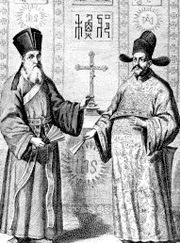
Mongol Empire
The Mongol Empire , initially named as Greater Mongol State was a great empire during the 13th and 14th centuries...
in the 13th century. Numerous traders - most famously Marco Polo
Marco Polo
Marco Polo was a Venetian merchant traveler from the Venetian Republic whose travels are recorded in Il Milione, a book which did much to introduce Europeans to Central Asia and China. He learned about trading whilst his father and uncle, Niccolò and Maffeo, travelled through Asia and apparently...
- had traveled between eastern and western Eurasia. Christianity was not new to the Mongols, as many had practiced Christianity of the Church of the East since the 7th century (see Christianity among the Mongols
Christianity among the Mongols
In modern times the Mongols are primarily Buddhist, but in previous eras, especially during the time of the Mongol "empire" , they were primarily shamanist and had a substantial minority of Christians, many of whom were in positions of considerable power. Overall, Mongols were highly tolerant of...
). However, the overthrow of the Mongol Yuan Dynasty
Yuan Dynasty
The Yuan Dynasty , or Great Yuan Empire was a ruling dynasty founded by the Mongol leader Kublai Khan, who ruled most of present-day China, all of modern Mongolia and its surrounding areas, lasting officially from 1271 to 1368. It is considered both as a division of the Mongol Empire and as an...
by the Ming
Ming Dynasty
The Ming Dynasty, also Empire of the Great Ming, was the ruling dynasty of China from 1368 to 1644, following the collapse of the Mongol-led Yuan Dynasty. The Ming, "one of the greatest eras of orderly government and social stability in human history", was the last dynasty in China ruled by ethnic...
in 1368 resulted in a strong assimilatory
Cultural assimilation
Cultural assimilation is a socio-political response to demographic multi-ethnicity that supports or promotes the assimilation of ethnic minorities into the dominant culture. The term assimilation is often used with regard to immigrants and various ethnic groups who have settled in a new land. New...
pressure on China's Muslim, Jewish, and Christian communities, and outside influences were forced out of China. By the 16th century, there is no reliable information about any practicing Christians remaining in China.
The first Portuguese explorer credited with reaching China was Jorge Álvares
Jorge Álvares
Jorge Álvares is credited as the first Portuguese explorer to have reached China and Hong Kong. The Fundação Jorge Álvares , founded by Vasco Joaquim Rocha Vieira prior to the handover of Macau, got its name from him also having reached there.-Exploration:In May 1513 Álvares sailed under the...
in 1513. Unlike the early European travelers of the 14th and 15th centuries, who reached China overland by traveling thousands of miles through Mongol- or Muslim-controlled territory, during the Age of Discovery
Age of Discovery
The Age of Discovery, also known as the Age of Exploration and the Great Navigations , was a period in history starting in the early 15th century and continuing into the early 17th century during which Europeans engaged in intensive exploration of the world, establishing direct contacts with...
of the 15th to 17th centuries Europeans started arriving on China's southeastern coast in their own boats, from Portuguese-controlled Malacca
Malacca
Malacca , dubbed The Historic State or Negeri Bersejarah among locals) is the third smallest Malaysian state, after Perlis and Penang. It is located in the southern region of the Malay Peninsula, on the Straits of Malacca. It borders Negeri Sembilan to the north and the state of Johor to the south...
or the Spanish Philippines
Philippines
The Philippines , officially known as the Republic of the Philippines , is a country in Southeast Asia in the western Pacific Ocean. To its north across the Luzon Strait lies Taiwan. West across the South China Sea sits Vietnam...
.
Fairly soon after the establishment of the direct European maritime contact with China (1513) and the creation of the Society of Jesus
Society of Jesus
The Society of Jesus is a Catholic male religious order that follows the teachings of the Catholic Church. The members are called Jesuits, and are also known colloquially as "God's Army" and as "The Company," these being references to founder Ignatius of Loyola's military background and a...
(1540), at least some Chinese become involved with the Jesuit effort. As early as 1546, two Chinese boys enrolled in the Jesuits' St. Paul's College
Saint Paul's College, Goa
St. Paul's College was a Jesuit college founded circa 1542 at Old Goa. It was once the main Jesuit institution in India. It housed the first printing press in India, having published the first books in 1556...
in Goa
Goa
Goa , a former Portuguese colony, is India's smallest state by area and the fourth smallest by population. Located in South West India in the region known as the Konkan, it is bounded by the state of Maharashtra to the north, and by Karnataka to the east and south, while the Arabian Sea forms its...
, the capital of Portuguese India. One of these two Christian Chinese, known as Antonio, accompanied St. Francis Xavier
Francis Xavier
Francis Xavier, born Francisco de Jasso y Azpilicueta was a pioneering Roman Catholic missionary born in the Kingdom of Navarre and co-founder of the Society of Jesus. He was a student of Saint Ignatius of Loyola and one of the first seven Jesuits, dedicated at Montmartre in 1534...
, a co-founder of the Society of Jesus, when he decided to start missionary work in China. However, Xavier failed to find a way to enter the Chinese mainland, and died in 1552 on Shangchuan island off the coast of Guangdong
Guangdong
Guangdong is a province on the South China Sea coast of the People's Republic of China. The province was previously often written with the alternative English name Kwangtung Province...
, the only place in China where Europeans were allowed to stay at the time, but only for seasonal trade.
A few years after Xavier's death, the Portuguese were allowed to establish Macau
Macau
Macau , also spelled Macao , is, along with Hong Kong, one of the two special administrative regions of the People's Republic of China...
, a semi-permanent settlement on the mainland which was about 100 km closer to the Pearl River Delta
Pearl River Delta
The Pearl River Delta , Zhujiang Delta or Zhusanjiao in Guangdong province, People's Republic of China is the low-lying area surrounding the Pearl River estuary where the Pearl River flows into the South China Sea...
than Shangchuan Island. A number of Jesuits visited the place (as well as the main Chinese port in the region, Guangzhou
Guangzhou
Guangzhou , known historically as Canton or Kwangchow, is the capital and largest city of the Guangdong province in the People's Republic of China. Located in southern China on the Pearl River, about north-northwest of Hong Kong, Guangzhou is a key national transportation hub and trading port...
) on occasion, and in 1563 the Order permanently established its settlement in the small Portuguese colony. However, the early Macau Jesuits did not learn Chinese, and their missionary work could reach only the very small number of Chinese people in Macau who spoke Portuguese.
A new regional manager ("Visitor") of the order, Alessandro Valignano
Alessandro Valignano
Alessandro Valignano, , was a Jesuit missionary born in Chieti, back then part of the Kingdom of Naples, who helped supervise the introduction of Catholicism to the Far East, and especially to Japan....
, on his visit to Macau in 1578-1579 realized that Jesuits weren't going to get far in China without a sound grounding in the language and culture of the country. He founded St. Paul Jesuit College (Macau) and requested the Order's superiors in Goa to send a suitably talented person to Macau to start the study of Chinese. Accordingly, in 1579 the Italian Michele Ruggieri
Michele Ruggieri
Michele Ruggieri was an Italian Jesuit priest. One of the founding fathers of the Jesuit China missions, and a co-author of the first Portuguese-Chinese dictionary, he can be described as the first European sinologist.-Formation years in Europe:Before entering the Society of Jesus Michele...
(1543–1607) was sent to Macau, and in 1582 he was joined at his task by another Italian, Matteo Ricci
Matteo Ricci
Matteo Ricci, SJ was an Italian Jesuit priest, and one of the founding figures of the Jesuit China Mission, as it existed in the 17th-18th centuries. His current title is Servant of God....
(1552–1610).
Ricci's policy of accommodation
Ricci, Ruggieri, and their followers, had a desire of creating a Sino-Christian civilization that would match the Roman-Christian civilization of the West. Both Ricci and Ruggieri were determined to adapt to the religious qualities of the Chinese: Ruggieri to the common people, in whom Buddhist and Taoist elements predominated, and Ricci to the educated classes, where ConfucianismConfucianism
Confucianism is a Chinese ethical and philosophical system developed from the teachings of the Chinese philosopher Confucius . Confucianism originated as an "ethical-sociopolitical teaching" during the Spring and Autumn Period, but later developed metaphysical and cosmological elements in the Han...
prevailed. Ricci, who arrived at the age of 30 and spent the rest of his life in China, wrote to the Jesuit houses in Europe and called for priests - men who would not only be "good", but also "men of talent, since we are dealing here with a people both intelligent and learned".
A few responded, and Ricci began to train them so that they might approach the Chinese authorities, offering the court scholarly and scientific assistance. Ricci's followers had the deliberate intention of completely de-westernizing themselves, to make a Confucian adaptation of their style of life, patterns of thought, preaching and worship. Both Ricci and Ruggieri felt that it would be possible to "prove that the Christian doctrines were already laid down in the classical works of the Chinese people, albeit in disguise". Indeed, they and their followers were convinced that "the day would come when with one accord all missionaries in China would look in the ancient texts for traces of primal revelation".

Taoism
Taoism refers to a philosophical or religious tradition in which the basic concept is to establish harmony with the Tao , which is the mechanism of everything that exists...
, while Ruggieri's thesis was that there was a closer affinity between the Tao of Chinese thought and the incarnate Logos of the New Testament.
In 1584 Ruggieri published the first Jesuit Latin book in China, which was later translated into Chinese by Ricci with a name of Tien Zhu Shi-lu (天主實錄 The True Account of God). In it he discussed the existence and attributes of God, as well as his providence. He explained how a man might know God through the natural law, the Mosaic law, and the Christian law. He wrote of the incarnation of Christ the Word and discussed the sacraments.
In his diary, Ricci wrote: "From morning to night, I am kept busy discussing the doctrines of our faith. Many desire to forsake their idols and become Christians". His missionary directives were explicit:
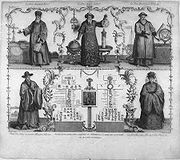
"The work of evangelization, of making Christians, should be carried on both in Peking and in the provinces… following the methods of pacific penetration and cultural adaptation. Europeanism is to be shunned. Contact with Europeans, specifically with the PortuguesePortuguese peopleThe Portuguese are a nation and ethnic group native to the country of Portugal, in the west of the Iberian peninsula of south-west Europe. Their language is Portuguese, and Roman Catholicism is the predominant religion....
in MacauMacauMacau , also spelled Macao , is, along with Hong Kong, one of the two special administrative regions of the People's Republic of China...
, should be reduced to a minimum. Strive to make good Christians rather than multitudes of indifferent Christians… Eventually when we have a goodly number of Christians, then perhaps it would not be impossible to present some memorial to the Emperor asking that the right of Christians to practice their religion be accorded, inasmuch as is not contrary to the laws of China. Our Lord will make known and discover to us little by little the appropriate means for bringing about in this matter His holy will.
When Ricci died in 1610 in Beijing, more than two thousand Chinese from all levels of society had confessed their faith in Jesus Christ. Just as Ricci spent his life in China, others of his followers did the same. This level of commitment was necessitated by logistical reasons: Travel from Europe to China took many months, and sometimes years; and learning the country's language and culture was even more time-consuming. When a Jesuit from China did travel back to Europe, he typically did it as a representative ("procurator") of the China Mission, entrusted with the task of recruiting more Jesuit priests to come to China, ensuring continued support for the Mission from the Church's central authorities, and creating favorable publicity for the Mission and its policies by publishing both scholarly and popular literature about China and Jesuits. One time Chongzhen Emperor
Chongzhen Emperor
The Chongzhen Emperor was the 16th and last emperor of the Ming Dynasty in China. He reigned from 1627 to 1644, under an era name that means "honorable and auspicious".- Early years :...
was nearly converted to Christianity and broke his idols.
Dynastic change
The fall of the Ming DynastyMing Dynasty
The Ming Dynasty, also Empire of the Great Ming, was the ruling dynasty of China from 1368 to 1644, following the collapse of the Mongol-led Yuan Dynasty. The Ming, "one of the greatest eras of orderly government and social stability in human history", was the last dynasty in China ruled by ethnic...
(1644) and the conquest of China by the Manchu
Manchu
The Manchu people or Man are an ethnic minority of China who originated in Manchuria . During their rise in the 17th century, with the help of the Ming dynasty rebels , they came to power in China and founded the Qing Dynasty, which ruled China until the Xinhai Revolution of 1911, which...
Qing
Qing Dynasty
The Qing Dynasty was the last dynasty of China, ruling from 1644 to 1912 with a brief, abortive restoration in 1917. It was preceded by the Ming Dynasty and followed by the Republic of China....
regime brought some difficult years for the Jesuits in China. While some Jesuit fathers managed to impress Manchu commanders with a display of western science of ecclesiastical finery and to be politely invited to join the new order (as did Johann Adam Schall von Bell
Johann Adam Schall von Bell
Johann Adam Schall von Bell was a German Jesuit and astronomer. He spent most of his life as a missionary in China and became an adviser to the Chinese emperor.- Life :...
in Beijing in 1644, or Martino Martini
Martino Martini
Martino Martini was an Italian Jesuit missionary, cartographer and historian, mainly working on ancient Imperial China.-Early years:Martini was born in Trento, in the Bishopric of Trent...
in Wenzhou
Wenzhou
Wenzhou is a prefecture-level city in southeastern Zhejiang province, People's Republic of China. The area under its jurisdiction, which includes two satellite cities and six counties, had a population of 9,122,100 as of 2010....
ca. 1645-46), others endured imprisonment and privations, as did Lodovico Buglio
Lodovico Buglio
Lodovico Buglio was an Italian Jesuit mathematician and theologian, a missionary in China.-Life:He was born at Mineo, Sicily, 26 January 1606; He entered the Society of Jesus, 29 January 1622, and, after a career as a professor of the humanities and rhetoric in the Roman College, asked to be sent...
and Gabriel de Magalhaes in Sichuan
Sichuan
' , known formerly in the West by its postal map spellings of Szechwan or Szechuan is a province in Southwest China with its capital in Chengdu...
in 1647-48 or Alvaro Semedo
Alvaro Semedo
Álvaro de Semedo , was a Portuguese Jesuit missionary in China.Alvaro Semedo was born in Niza, Portugal in 1585 or 1586...
in Canton
Guangzhou
Guangzhou , known historically as Canton or Kwangchow, is the capital and largest city of the Guangdong province in the People's Republic of China. Located in southern China on the Pearl River, about north-northwest of Hong Kong, Guangzhou is a key national transportation hub and trading port...
in 1649. Later, Johann Grueber
Johann Grueber
Johann Grueber was an Austrian Jesuit missionary and astronomer in China, and noted explorer.-Life:...
was in Beijing between 1656 and 1661.

Southern Ming Dynasty
The Southern Ming Dynasty was the Ming loyalist regime that continued in Southern China from 1644 to 1662 following the capture of Beijing by rebel armies and the death of the last Ming emperor in 1644....
, it was not uncommon for some Jesuits to find themselves on different sides of the front lines: while Adam Schall was an important counselor of the Qing Shunzhi Emperor
Shunzhi Emperor
The Shunzhi Emperor was the third emperor of the Manchu-led Qing dynasty, and the first Qing emperor to rule over China, which he did from 1644 to 1661. "Shunzhi" was the name of his reign period...
in Beijing, Michał Boym travelled from the jungles of south-western China to Rome, carrying the plea of help from the court of the last Southern Ming emperor Zhu Youlang
Zhu Youlang, Prince of Gui
Zhu Youlang, Prince of Gui, the Yongli Emperor was the fourth and last emperor of the Southern Ming Dynasty of China. His era name means "Perpetual calendar"....
(the Yongli Emperor), and returned with the Pope's response that promised prayer, after some military assistance from Macau. The emperor was against monogamy
Monogamy
Monogamy /Gr. μονός+γάμος - one+marriage/ a form of marriage in which an individual has only one spouse at any one time. In current usage monogamy often refers to having one sexual partner irrespective of marriage or reproduction...
but many people in his court had been baptized.
French Jesuits
In 1685, the French king Louis XIV sent a mission of five Jesuit "mathematicians" to China in an attempt to break the Portuguese predominance: Jean de FontaneyJean de Fontaney
Jean de Fontaney was a French Jesuit who led a mission to China in 1687.Jean de Fontaney had been a teacher of mathematics and astronomy at the College Louis le Grand...
(1643–1710), Joachim Bouvet
Joachim Bouvet
Joachim Bouvet was a French Jesuit who worked in China, and the leading member of the Figurist movement.-Biography:...
(1656–1730), Jean-François Gerbillon
Jean-François Gerbillon
Jean-François Gerbillon was a French missionary, who worked in China.He entered the Society of Jesus, 5 Oct, 1670, and after completing the usual course of study taught grammar and humanities for seven years...
(1654–1707), Louis Le Comte
Louis le Comte
Louis le Comte , also Louis-Daniel Lecomte, was a French Jesuit who participated in the 1687 French Jesuit mission to China under Jean de Fontaney. He arrived in China on 7 February 1688....
(1655–1728) and Claude de Visdelou
Claude de Visdelou
Claude de Visdelou was a French Jesuit missionary.-Life:De Visdelou was born at the Château de Bienassis, Erquy, Brittany. He entered the Society of Jesus on 5 September 1673, and was one of the missionaries sent to China by Louis XIVin 1687. He acquired a wide knowledge of the Chinese language...
(1656–1737).
Travel of Chinese Christians to Europe
Prior to the Jesuits, there had already been Chinese pilgrims who had made the journey westward, with two notable examples being Rabban bar SaumaRabban Bar Sauma
Rabban Bar Sauma , also known as Rabban Ṣawma or Rabban Çauma, , was a Turkic/Mongol monk turned diplomat of the Nestorian Christian faith. He is known for embarking on a pilgrimage from Mongol-controlled China to Jerusalem with one of his students, Rabban Markos...
and his younger companion who became Patriarch Mar Yaballaha III, in the 13th century.
While not too many 17th-century Jesuits ever went back from China to Europe, it was not uncommon for them to be accompanied by young Chinese Christians. One of the earliest Chinese travelers to Europe was Andreas Zheng (郑安德勒; Wade-Giles
Wade-Giles
Wade–Giles , sometimes abbreviated Wade, is a romanization system for the Mandarin Chinese language. It developed from a system produced by Thomas Wade during the mid-19th century , and was given completed form with Herbert Giles' Chinese–English dictionary of 1892.Wade–Giles was the most...
: Cheng An-te-lo), who was sent to Rome by the Yongli court along with Michał Boym in the late 1650. Zheng and Boym stayed in Venice
Venice
Venice is a city in northern Italy which is renowned for the beauty of its setting, its architecture and its artworks. It is the capital of the Veneto region...
and Rome
Rome
Rome is the capital of Italy and the country's largest and most populated city and comune, with over 2.7 million residents in . The city is located in the central-western portion of the Italian Peninsula, on the Tiber River within the Lazio region of Italy.Rome's history spans two and a half...
in 1652-55. Zheng worked with Boym on the transcription and translation of the Nestorian Monument
Nestorian Stele
The Nestorian Stele is aTang Chinese stele erected in 781 that documents 150 years of history of early Christianity in China. It is a 279-cm tall limestone block with text in both Chinese and Syriac, describing the existence of Christian communities in several cities in northern China...
, and returned to Asia with Boym, whom he buried when the Jesuit died near the Vietnam-China border. A few years later, another Chinese traveller who was called Matthaeus Sina in Latin (not positively identified, but possibly the person who traveled from China to Europe overland with Johann Grueber
Johann Grueber
Johann Grueber was an Austrian Jesuit missionary and astronomer in China, and noted explorer.-Life:...
) also worked on the same Nestorian inscription. The result of their work was published by Athanasius Kircher
Athanasius Kircher
Athanasius Kircher was a 17th century German Jesuit scholar who published around 40 works, most notably in the fields of oriental studies, geology, and medicine...
in 1667 in the China Illustrata, and was the first significant Chinese text ever published in Europe.Mungello (1989), p. 167
Better known is the European trip of Shen Fo-tsung in 1684–1685, who was presented to king Louis XIV on September 15, 1684, and also met with king James II
James II of England
James II & VII was King of England and King of Ireland as James II and King of Scotland as James VII, from 6 February 1685. He was the last Catholic monarch to reign over the Kingdoms of England, Scotland, and Ireland...
, becoming the first recorded instance of a Chinese man visiting Britain. The king was so delighted by this visit that he had his portrait made, and had it hung in his bedroom. Later, Arcadio Huang
Arcadio Huang
Arcadio Huang, also Arcadius Huang or Arcade Huang , was a Chinese Christian convert, brought to Paris by the Missions étrangères. He took a pioneering role in the teaching of the Chinese language in France around 1715...
, another Chinese Jesuit, would also visit France, and was an early pioneer in the teaching of the Chinese language in France in 1715.
Scientific exchange
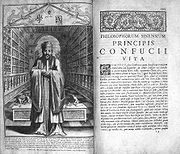
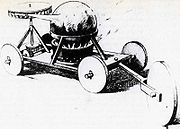
Telling China about Europe
The Jesuits introduced Western science and math, then undergoing its own revolution, to China. "Jesuits were accepted in late Ming court circles as foreign literati, regarded as impressive especially for their knowledge of astronomy, calendar-making, mathematics, hydraulics, and geography." In 1627, the Jesuit Johann SchreckJohann Schreck
Johann Schreck, also Terrenz or Terrentius Constantiensis, Deng Yuhan Hanpo, Deng Zhen Lohan, was a German Jesuit, missionary to China and polymath...
produced the first book to present Western mechanical knowledge to a Chinese audience, Diagrams and explanations of the wonderful machines of the Far West
Diagrams and explanations of the wonderful machines of the Far West
Diagrams and explanations of the wonderful machines of the Far West was an encyclopedia of Western mechanical devices translated into Chinese by the Jesuit Johann Schreck , and the Chinese scholar Wang Zheng...
. This influence worked in both directions:
Sabatino de Ursis
Sabatino de Ursis
Sabatino de Ursis was an Italian Jesuit who was active in 17th-century China, during the Jesuit China missions.-Career:...
(1575–1620) worked with Matteo Ricci
Matteo Ricci
Matteo Ricci, SJ was an Italian Jesuit priest, and one of the founding figures of the Jesuit China Mission, as it existed in the 17th-18th centuries. His current title is Servant of God....
on the Chinese translation of Euclid
Euclid
Euclid , fl. 300 BC, also known as Euclid of Alexandria, was a Greek mathematician, often referred to as the "Father of Geometry". He was active in Alexandria during the reign of Ptolemy I...
's Elements
Euclid's Elements
Euclid's Elements is a mathematical and geometric treatise consisting of 13 books written by the Greek mathematician Euclid in Alexandria c. 300 BC. It is a collection of definitions, postulates , propositions , and mathematical proofs of the propositions...
, published books in Chinese on Western hydraulics, and by predicting an eclipse which Chinese astronomers had not anticipated, opened the door to the reworking of the Chinese calendar
Chinese calendar
The Chinese calendar is a lunisolar calendar, incorporating elements of a lunar calendar with those of a solar calendar. It is not exclusive to China, but followed by many other Asian cultures as well...
using Western calculation techniques.
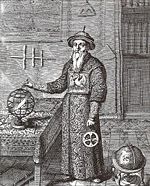
Johann Adam Schall von Bell
Johann Adam Schall von Bell was a German Jesuit and astronomer. He spent most of his life as a missionary in China and became an adviser to the Chinese emperor.- Life :...
(1591–1666), a German Jesuit missionary to China organized successful missionary work, and became the trusted counsellor of the Shunzhi emperor
Shunzhi Emperor
The Shunzhi Emperor was the third emperor of the Manchu-led Qing dynasty, and the first Qing emperor to rule over China, which he did from 1644 to 1661. "Shunzhi" was the name of his reign period...
of the Qing dynasty
Qing Dynasty
The Qing Dynasty was the last dynasty of China, ruling from 1644 to 1912 with a brief, abortive restoration in 1917. It was preceded by the Ming Dynasty and followed by the Republic of China....
. He was created a mandarin
Mandarin (bureaucrat)
A mandarin was a bureaucrat in imperial China, and also in the monarchist days of Vietnam where the system of Imperial examinations and scholar-bureaucrats was adopted under Chinese influence.-History and use of the term:...
, and held an important post in connection with the mathematical school, contributing to astronomical studies and the development of the Chinese calendar. Thanks to Schall, the motions of both the sun and moon began to be calculated with sinusoids
Trigonometric function
In mathematics, the trigonometric functions are functions of an angle. They are used to relate the angles of a triangle to the lengths of the sides of a triangle...
in the 1645 Shíxiàn calendar (時憲書, Book of the Conformity of Time). His position enabled him to procure from the emperor permission for the Jesuits to build churches and to preach throughout the country. The Shunzhi emperor, however, died in 1661, and Schall's circumstances at once changed. He was imprisoned and condemned to slow slicing death. After an earthquake and the dowager's objection the sentence was not carried out, but he died after his release owing to the privations he had endured. A collection of his manuscripts remains, and was deposited in the Vatican Library
Vatican Library
The Vatican Library is the library of the Holy See, currently located in Vatican City. It is one of the oldest libraries in the world and contains one of the most significant collections of historical texts. Formally established in 1475, though in fact much older, it has 75,000 codices from...
. After he and Ferdinand Verbiest
Ferdinand Verbiest
Father Ferdinand Verbiest was a Flemish Jesuit missionary in China during the Qing dynasty. He was born in Pittem near Tielt in Flanders, later part of the modern state of Belgium. He is known as Nan Huairen in Chinese...
won the tests against Chinese and Islamic calendar scholars, the court adapted the western calendar only.
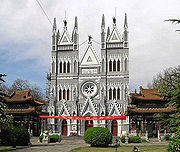
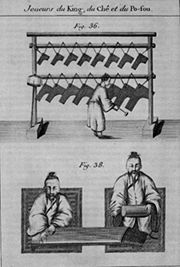
Cathedral of the Immaculate Conception in Beijing
The Cathedral of the Immaculate Conception in Beijing , also known as Nantang to the locals, is a historic Roman Catholic Church located in Beijing, China...
(Southern) Church, and in 1655 the Dongtang
Wangfujing Cathedral
The Wangfujing Cathedral , also named St. Joseph's Wangfujing Cathedral or to the locals, Dongtang is a historic Catholic cathedral located in downtown Beijing, near Wangfujing. A small church was first established in 1653 on the open grounds by the Jesuit Father Lodovico Buglio...
(Eastern) Church. In 1703 they established the Beitang (Northern) Church near Zhongnanhai
Zhongnanhai
Zhongnanhai is an area in central Beijing, China adjacent to the Forbidden City which serves as the central headquarters for the Communist Party of China and the State Council of the People's Republic of China. The term Zhongnanhai is closely linked with the central government and senior Communist...
(opposite the former Beijing Library), on a land bestowed by Emperor Kangxi of the Qing Dynasty
Qing Dynasty
The Qing Dynasty was the last dynasty of China, ruling from 1644 to 1912 with a brief, abortive restoration in 1917. It was preceded by the Ming Dynasty and followed by the Republic of China....
to the Jesuit in 1694, following his recovery from illness thanks to medical expertise of Fathers Jean-François Gerbillon
Jean-François Gerbillon
Jean-François Gerbillon was a French missionary, who worked in China.He entered the Society of Jesus, 5 Oct, 1670, and after completing the usual course of study taught grammar and humanities for seven years...
and Joachim Bouvet
Joachim Bouvet
Joachim Bouvet was a French Jesuit who worked in China, and the leading member of the Figurist movement.-Biography:...
.
Telling Europe about China
The Jesuits were also very active in transmitting Chinese knowledge to Europe, such as translating ConfuciusConfucius
Confucius , literally "Master Kong", was a Chinese thinker and social philosopher of the Spring and Autumn Period....
's works into European languages. Ricci in his De Christiana expeditione apud Sinas
De Christiana expeditione apud Sinas
De Christiana expeditione apud Sinas suscepta ab Societate Jesu is a book based on an Italian manuscript written by the most important founding figure of the Jesuit China mission, Matteo Ricci , expanded and translated into Latin by his colleague Nicolas Trigault...
had already started to report on the thoughts of Confucius; he (and, earlier, Michele Ruggieri
Michele Ruggieri
Michele Ruggieri was an Italian Jesuit priest. One of the founding fathers of the Jesuit China missions, and a co-author of the first Portuguese-Chinese dictionary, he can be described as the first European sinologist.-Formation years in Europe:Before entering the Society of Jesus Michele...
) made attempts at translating the Four Books, the standard introduction into the Confucian canon. The work of several generations of Jesuits on the Confucian classics culminated with Fathers Philippe Couplet
Philippe Couplet
Philippe Couplet, also Philip Couplet or Philippus Couplet , was a Belgian Jesuit Father who was active in China in the 17th century. He was born in Mechelen, Spanish Netherlands ....
, Prospero Intorcetta
Prospero Intorcetta
Prospero Intorcetta was a Jesuit who was active in China in the 17th century. He reached China in 1659, together with the French Jesuit Philippe Couplet, and worked in the Jiangnan region.-Works:...
et al. publishing Confucius Sinarum Philosophus ("Confucius, the Philosopher of the Chinese") in Paris in 1687. The book contained an annotated Latin
Latin
Latin is an Italic language originally spoken in Latium and Ancient Rome. It, along with most European languages, is a descendant of the ancient Proto-Indo-European language. Although it is considered a dead language, a number of scholars and members of the Christian clergy speak it fluently, and...
translation of three of the Four Books, and a biography of Confucius. It is thought that such works had considerable importance on European thinkers of the period, particularly those who were interested by the integration of the system of morality of Confucius into Christianity
Christianity
Christianity is a monotheistic religion based on the life and teachings of Jesus as presented in canonical gospels and other New Testament writings...
.
Since the mid-17th century, detailed Jesuits' accounts of the Eight trigrams and the Yin/Yang principles appeared in Europe; soon, they attracted significant attention of European philosophers, such as Leibniz
Gottfried Leibniz
Gottfried Wilhelm Leibniz was a German philosopher and mathematician. He wrote in different languages, primarily in Latin , French and German ....
.
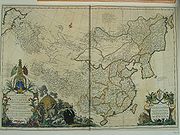
Manchu language
Manchu is a Tungusic endangered language spoken in Northeast China; it used to be the language of the Manchu, though now most Manchus speak Mandarin Chinese and there are fewer than 70 native speakers of Manchu out of a total of nearly 10 million ethnic Manchus...
dictionary Dictionnaire tatare-mantchou-français (Paris, 1789), a work of great value, the language having been previously quite unknown in Europe
Europe
Europe is, by convention, one of the world's seven continents. Comprising the westernmost peninsula of Eurasia, Europe is generally 'divided' from Asia to its east by the watershed divides of the Ural and Caucasus Mountains, the Ural River, the Caspian and Black Seas, and the waterways connecting...
. He also wrote a 15 volume Treaty regarding the history, sciences and art of the Chinese, published in Paris in 1776-1791 (Mémoires concernant l'histoire, les sciences et les arts des Chinois, 15 volumes, Paris, 1776–1791). His Vie de Confucius
Confucius
Confucius , literally "Master Kong", was a Chinese thinker and social philosopher of the Spring and Autumn Period....
, the twelfth volume of that collection, was more complete and accurate than any predecessors.
In the early years of the 18th century, Jesuit cartographers travelled all over the Chinese Empire, performing astronomical observations to determine latitude and longitude (relative to Beijing) of various locations and drawing maps. Their work was summarized in a four-volume Description géographique, historique, chronologique, politique et physique de l'empire de la Chine et de la Tartarie chinoise published by Jean-Baptiste Du Halde
Jean-Baptiste Du Halde
Jean-Baptiste Du Halde was a French Jesuit historian specializing in China. Although he had not gone to China, he collected seventeen Jesuit missionaries' reports and provided encyclopedic survey on Chinese history, culture and society....
in Paris in 1735, and a map compiled by Jean Baptiste Bourguignon d'Anville
Jean Baptiste Bourguignon d'Anville
Jean Baptiste Bourguignon d'Anville , was both a geographer and cartographer who greatly improved the standards of map-making. His maps of ancient geography, characterized by careful, accurate work and based largely on original research, are especially valuable...
(published 1734).
Chinese Rites Controversy
In the early 18th century, a dispute within the Catholic Church arose over whether Chinese folk religion rituals and offerings to the emperor constituted paganismPaganism
Paganism is a blanket term, typically used to refer to non-Abrahamic, indigenous polytheistic religious traditions....
or idolatry
Idolatry
Idolatry is a pejorative term for the worship of an idol, a physical object such as a cult image, as a god, or practices believed to verge on worship, such as giving undue honour and regard to created forms other than God. In all the Abrahamic religions idolatry is strongly forbidden, although...
. This tension led to what became known as the "Rites Controversy," a bitter struggle that broke out after Ricci's death and lasted for over a hundred years.
At first the focal point of dissension was the Jesuit Ricci's contention that the ceremonial rites of Confucianism
Confucianism
Confucianism is a Chinese ethical and philosophical system developed from the teachings of the Chinese philosopher Confucius . Confucianism originated as an "ethical-sociopolitical teaching" during the Spring and Autumn Period, but later developed metaphysical and cosmological elements in the Han...
and ancestor veneration
Ancestor Veneration in China
Ancestral veneration in Chinese culture is the practice of living family members who try to provide a deceased family member with continuous happiness and well-being in the afterlife. It is a way of continuing to show respect towards them, and it reinforces the unity of family and lineage. Showing...
were primarily social and political in nature and could be practiced by converts. The Dominicans, however, charged that the practices were idolatrous, meaning that all acts of respect to the sage and one's ancestors were nothing less than the worship of demons. A Dominican carried the case to Rome, where it dragged on and on, largely because no one in the Vatican knew Chinese culture sufficiently to provide the pope with a ruling. Naturally, the Jesuits appealed to the Chinese emperor, who endorsed Ricci's position. Understandably, the emperor was confused, as to why missionaries were attacking missionaries in his capital, and asking him to choose one side over the other, when he might very well have simply ordered the expulsion of all of them.

Nestorian Stele
The Nestorian Stele is aTang Chinese stele erected in 781 that documents 150 years of history of early Christianity in China. It is a 279-cm tall limestone block with text in both Chinese and Syriac, describing the existence of Christian communities in several cities in northern China...
in 1623 enabled the Jesuits to strengthen their position with the court by answering an objection the Chinese often expressed - that Christianity was a new religion. The Jesuits could now point to concrete evidence that a thousand years earlier the Christian gospel had been proclaimed in China; it was not a new but an old faith. The emperor then decided to expel all missionaries who failed to support Ricci's position.
The Spanish Franciscans, however, did not retreat without further struggle. Eventually they persuaded Pope Clement XI
Pope Clement XI
Pope Clement XI , born Giovanni Francesco Albani, was Pope from 1700 until his death in 1721.-Early life:...
that the Jesuits were making dangerous accommodations to Chinese sensibilities. In 1704 they prescribed against the ancient use of the words Shang Di (supreme emperor) and Tien (heaven) for God. Again, the Jesuits appealed this decision.
The controversy raged on. In 1742 Pope Benedict XIV
Pope Benedict XIV
Pope Benedict XIV , born Prospero Lorenzo Lambertini, was Pope from 17 August 1740 to 3 May 1758.-Life:...
officially opposed the Jesuits, forbade all worship of ancestors, and terminated further discussion of the issue. This decree was repealed in 1938. But the methodology of Matteo Ricci remained suspect until 1958, when Pope John XXIII
Pope John XXIII
-Papal election:Following the death of Pope Pius XII in 1958, Roncalli was elected Pope, to his great surprise. He had even arrived in the Vatican with a return train ticket to Venice. Many had considered Giovanni Battista Montini, Archbishop of Milan, a possible candidate, but, although archbishop...
, by decree in his encyclical Princeps Pastorum, proposed that Ricci become "the model of missionaries."
In the intervening years the Ming Dynasty
Ming Dynasty
The Ming Dynasty, also Empire of the Great Ming, was the ruling dynasty of China from 1368 to 1644, following the collapse of the Mongol-led Yuan Dynasty. The Ming, "one of the greatest eras of orderly government and social stability in human history", was the last dynasty in China ruled by ethnic...
collapsed (1644), to be replaced by the "non-scholarly" and foreign Manchus. At first, the Jesuits were employed and welcome in the court of K'ang-hsi. However, when Pope Clement XI
Pope Clement XI
Pope Clement XI , born Giovanni Francesco Albani, was Pope from 1700 until his death in 1721.-Early life:...
attempted to send Maillard de Tournon
Charles-Thomas Maillard De Tournon
Charles-Thomas Maillard De Tournon was a papal legate and cardinal to the East Indies and China.-Biography:...
as an emissary to control the Jesuit Missionaries and restrict Christian tolerance and practice of Chinese Rites, the request was denied by K'ang-hsi. Further, Jesuit missionaries had to sign a document stating that they agreed to Confucian and ancestral rituals, and those who did not sign were deported. Maillard himself was imprisoned. In spite of this, the Jesuits continued to preach and work in China - but over time, the influence of the Catholic missionary orders began to wane. Pope Clement XIV
Pope Clement XIV
Pope Clement XIV , born Giovanni Vincenzo Antonio Ganganelli, was Pope from 1769 to 1774. At the time of his election, he was the only Franciscan friar in the College of Cardinals.-Early life:...
dissolved the Society of Jesus in 1773. The withdrawal from China of this dynamic segment of the missionary force exposed the church to successive waves of persecution. Although many Chinese Christians were put to death and the congregation scattered, the church continued to manifest a "tough inward vitality" and kept growing.
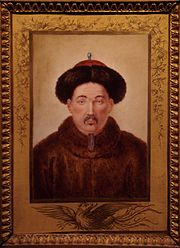
Louis Antoine de Poirot
Louis Antoine de Poirot was a Jesuit painter and translator of the 18th and early 19th century, who worked in the service of the Chinese emperor Qianlong adopting the Chinese name He Qingtai . He was the last of the Western painters who worked for Qianlong, together with Father Giuseppe Panzi...
(1735–1813) and Giuseppe Panzi (1734-before 1812) who worked for Emperor Qianlong as painters and translators. From the 19th century, the role of the Jesuits in China was largely taken over by the Paris Foreign Missions Society
Paris Foreign Missions Society
The Society of Foreign Missions of Paris is a Roman Catholic missionary organization. It is not a religious order, but an organization of secular priests and lay persons dedicated to missionary work in foreign lands....
.
See also
- 19th Century Protestant Missions in China
- Cathedral of Saint Paul in MacauCathedral of Saint Paul in MacauThe Ruins of St. Paul's refers to the ruins of a 16th century complex in Macau including of what was originally St. Paul's College and the Cathedral of St. Paul also known as "Mater Dei", a 17th century Portuguese cathedral dedicated to Saint Paul the Apostle. Today, the ruins are one of Macau's...
- Cathedral of the Immaculate Conception in HangzhouImmaculate Conception Cathedral of HangzhouThe Cathedral of Our Lady of the Immaculate Conception is a Roman Catholic cathedral, located at 415 Zhongshan Road North not far from Wulin Square in downtown Hangzhou, China...
- China and the Christian ImpactChina and the Christian ImpactChina and the Christian Impact was published in 1985 as the English translation of Jacques Gernet's Chine et christianisme of 1982. It received considerable attention from academic circles dealing with China and the Jesuit mission, mainly because of its approach to the subject from an almost...
, translation of Jacques GernetJacques GernetProfessor Jacques Gernet is an eminent French sinologist of the second half of the 20th century. His best-known work is The Chinese Civilization, a 900 page summary of Chinese history and civilization which has been translated into many languages.Gernet obtained a degree in classics at Algiers in...
's Chine et christianisme of 1982 - France-China relationsFrance-China relationsChina-France relations, also known as Sino-French relations or Franco-Chinese relations, refers to the interstate relations between China and France ....
- History of the Jews in ChinaHistory of the Jews in ChinaJews and Judaism in China have had a long history. Jewish settlers are documented in China as early as the 7th or 8th century CE, but may have arrived during the mid Han Dynasty, or even as early as 231 BCE. Relatively isolated communities developed through the Tang and Song Dynasties Jews and...
- Judaism in China
- List of Roman Catholic missionaries in China
- Medical missions in ChinaMedical missions in ChinaMedical missions in China by Protestant Christian physicians and surgeons of the 19th and early 20th centuries laid many foundations for modern medicine in China. Western medical missionaries established the first modern clinics and hospitals,provided the first training for nurses, and opened the...
- Roman Catholicism in ChinaRoman Catholicism in ChinaRoman Catholicism in China has a long and complicated history...
- Three Pillars of Chinese CatholicismThree Pillars of Chinese CatholicismXǔ Guāngqǐ of Shanghai, and Lǐ Zhīzǎo and Yáng Tíngyún both of Hangzhou, are known as the Three Great Pillars of Chinese Catholicism . It is due to their combined efforts that Hangzhou and Shanghai became the centre of missionary activity in late Ming China...
- Cornelius WesselsCornelius WesselsCornelius Wessels, SJ was a Dutch Jesuit, known for his historical works on the early Catholic Missions in Central Asia, specially Tibet, and in the East Indies....

